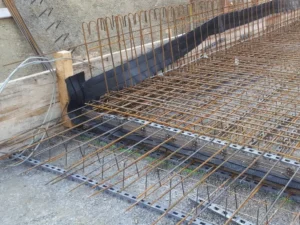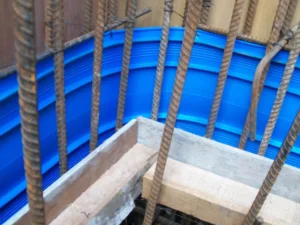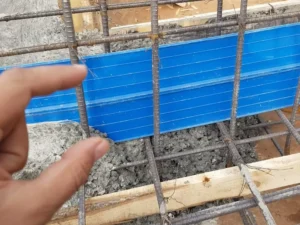A water stop is a crucial construction element used in every building made of concrete. Some of us may need to become more familiar with its working principle. What does it do? As the name suggests, its purpose is to stop water. So, people use this material to prevent water from entering a space. Yes, these water stoppers avoid the passage of water through joints or gaps in concrete structures. There are various types of water stoppers, where rubber & plastics are most popular. “Rubber waterstop vs PVC waterstop” shows the fundamental differences between these materials. Both rubber and PVC water stops are popular in construction applications. They have similar structures and are divided into back-mounted and middle-buried types. What sets them apart is their distinct materials.
Understanding the differences between these two products can help you make informed decisions. It allows you to choose suitable materials for your construction project. We will begin with the difference table so that you can quickly identify the fundamental differences. In the subsequent sections, we will learn more about their types, advantages, and limitations. Moreover, we will talk about some crucial factors you need in the selection process.
Rubber Waterstop vs PVC Waterstop
As mentioned earlier, rubber water stop & PVC water stop come with similar structures. What sets them apart is their construction material. Therefore, the following table mainly focuses on the primary material characteristics. When you compare the properties, you will find appropriate the water-stop material suitable for your project.
| Features | Rubber Water stop | PVC Water stop |
| Material Composition | Typically made from natural or synthetic rubber compounds, key advantages are flexibility & durability. | Composed of polyvinyl chloride; key advantages are chemical resistance & ease of fabrication |
| Types | Internal (CB & CP type) & external (EB & EP) types cover diverse project requirements. | Dumbell, Dumbell with center bulb, ribbed flat, ribbed with center bulb & tear web, base seal, split water-stop, cap water-stop |
| Flexibility | Excellent elongation, accommodating structural movements | It is less flexible than a rubber water stop. |
| Corrosion resistant | Generally resistant to corrosion but not as good as PVC water stop | Excellent corrosion resistant |
| Tensile strength | Exhibit good tensile strength | Known for high tensile strength |
| Temperature resistance | Suitable for a wide range of temperature applications | Excellent for low-temperature applications |
| Durability | Durable; withstands various environmental conditions | Also durable & long-lasting |
| Advantages | Excellent flexibility, adaptability to irregular shapes | High chemical resistance, low-temperature resistance, and Versatile |
| Limitations | Susceptible to edging, may require more maintenance | Limited flexibility in comparison to rubber may not be suitable for irregular surfaces |
| Cost | Competitively priced | Generally cheaper than a rubber water stop |
Rubber Water stop

A rubber water stop is a popular type of construction material. Its primary function is to prevent the passage of water through joints in concrete structures.
Rubber water stops are used more often than PVC water stops. Popular manufacturing processes include plasticization, mixing, extrusion, compression molding, and vulcanization.
There are different types of Rubber water stops. We have categorized them into two main sections.
Based on usage
- A buried water stop is the standard type of rubber waterproofing material. It is commonly used to construct underground concrete structures.
- The back stick-type water stop is made of a combination of natural rubber & synthetic rubber. Its composition also includes many additives & fillers. It mainly comes from plasticization, mixing, and compression molding.
Based on the form
- CB-type water stop: They are the middle hole of the buried water stop.
- CP-type water stop: They are in the middle of nonporous buried water.
- EP-type water stops are also known as “externally bonded water stops” or “backing water stops.” This designation indicates that water stops are marked outside the center of the no-pass.
- EB-type water stop: They are also known as posted outside water stop or backing with water stop.
Advantages
- Rubber water stop provides excellent flexibility.
- They provide excellent water-tightness.
- They exhibit good chemical resistance.
- Durable & efficient
- Rubber Water Stops can accommodate irregular surfaces.
Limitations
- Rubber water stops may be suitable for flexibility, but they are not ideal for low-temperature applications.
- Unlike PVC water stops, they can’t promise excellent corrosion resistance.
PVC Water stop

PVC is another popular material for making water stops. It also has extensive applications as a joint filler in concrete structures.
PVC water stoppers accommodate movement and settlements in concrete structures. They are also used to prevent the passage of water. PVC water stops come in various types.
- The Dumbell water stop is the largest and thickest profile. It is ideal for construction and contraction joints.
- Dumbell with a center bulb can withstand large-scale movements. They are also the largest & thickest water stop profiles.
- Ribbed flats are designed to enhance the bond strength between the water stop & surrounding concrete.
- Ribbed with center bulbs are designed to absorb the shear movements. It can be lateral or transversal direction.
- Ribbed with a torn web, it has a U-shaped center bulb. Its primary function is to pull when being subjected to large movements. Typical situations include joint expansion or differential settlements.
- The base seal is the simplest & easiest to install. You can use a regular splicing iron to perform heat welding.
- Split water stops have features similar to those of dumbbell water stops. What sets them apart is their structure and features. They are also ideal for construction joints with little or no movement.
- The cap water-stops have a cap that ensures a fluid-tight internal seal. They are ideal for expansion joints with expansion boards.
Advantages
- It provides excellent corrosion resistance.
- PVC water stops are ideal for low-temperature applications.
- It is 3-4 times more durable than rubber water stops.
- It is cheaper than a rubber water stop.
Limitations
- It is not as flexible as a rubber water stop.
- It is not suitable for use on irregular surfaces.
4 Main Considerations to Consider While Choosing a Water stop (Rubber Waterstop vs PVC Waterstop)

In the preceding sections, we have briefly described the rubber water stop & PVC water stop. Now, you can distinguish their differences. Let’s recap our discussion & evaluate how to choose the right product for your project. To do this, we can consider four important Factors.
Factor#1 Material
The material of a water stop is a critical determinant of its performance. You know, rubber & PVC each offer distinct properties. Consequently, these material properties affect the durability, flexibility, and resistivity. Therefore, the selection must align with the specific demands of the project. As a result, you or your engineer can ensure that the chosen water stop can withstand certain environmental conditions.
Factor#2 Installation method
The installation method also significantly influences the functionality of the water. Two types of installation methods are often used in construction applications. These are internal & external installations. Moreover, proper installation ensures a secure & watertight seal. It prevents leaks & ensures long-term effectiveness. The method may vary depending on the chosen water-stop material.
Factor#3 Size
Size considerations are also paramount in achieving an optimal seal. Your chosen water stop must be appropriately sized to accommodate concrete joint movement. It also prevents displacement. Oversized or undersized water stops can compromise the overall effectiveness of the seal. Therefore, it is necessary to go for precise sizing.
Factor#4 Application Environment
Finally, evaluating the application environment parameters is necessary when choosing the right type. Rubber water stops may be excellent in certain conditions, while PVC water stops might be more suitable in others.
FAQ
What are the different types of water stops?
There are four types of water stops that you can use in your construction. These are rubber water stops, PVC water stops, metal water stops, and bentonite water stops. Rubber and PVC water stops are considered the most popular in this case.
Which is better, rubber water stop or PVC water stop?
The choice between rubber & PVC water stops depends on specific project requirements. For example, rubber waters are ideal for flexibility & adaptability in construction joints. Conversely, PVC water stops are known for their corrosion resistance & low-temperature resistance.
How long does PVC rubber water stop last?
Usually, plastic water stops last 3-5 times longer than rubber water stops. However, PVC rubber water stops last more than 40 years. The lifespan typically depends on adequately selecting the water stops during the installation.
What is the difference between TPV & PVC water stop?
TPV is a combination of rubber and plastic, providing both characteristics. The main difference between TPV and PVC water stops is their flexibility. TPV is more flexible than traditional PVC. It typically allows for greater movement accommodation in construction joints.
Summary
Let’s wrap up everything! Rubber water stops & PVC water stops are both popular in construction applications. They reveal different characteristics that make them suitable for specific applications. Rubber water stops offer enhanced flexibility & adaptability.
PVC water stops are very good at withstanding low temperatures and rust. Remember that rubber and PVC water stops might not work in all situations. Because of this, you need to pick the suitable material for the job based on the application’s needs.
There are four things you need to think about when picking a water-stop material. The four are material, installation method, size, and use context. Whether the water stop is made of rubber or PVC affects how well it works and how long it lasts.
Also, size is a crucial thing to think about for accurate fitting. After that, the other two factors decide how long the water stoppers last and how well they work.
Above all, if you have any questions about rubber water stops vs. PVC water stops, don’t hesitate to get in touch with our customer support team.
